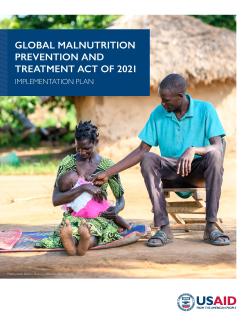In October 2022, President Biden signed the Global Malnutrition Prevention and Treatment Act (GMPTA) into law; it directs USAID to prevent and treat malnutrition globally. The GMPTA further codifies USAID’s leadership on nutrition, with a focus on evidence-based interventions across health systems and food systems in both development and humanitarian settings.
The GMPTA recognizes the potential of good nutrition to save lives and ensure a brighter future for generations to come. For over 60 years, USAID has been a leader in the fight to end global malnutrition. Nutrition affects every aspect of human development, from the ability to fight disease to children’s performance in school to a nation’s health and economic advancement. There is overwhelming evidence of the power of good nutrition, but accessing safe, nutritious foods and water along with health and sanitation services, remains a challenge for many people in low- and middle-income countries.
Robust leadership from the U.S. government is more important now than ever to buffer shocks and stressors while mitigating further deterioration and regaining progress in reaching World Health Assembly and Sustainable Development Goal nutrition targets. USAID is committed to addressing these global challenges and preventing further backsliding on nutrition.
Building on the U.S.’s long history as the largest provider of international agriculture, economic-development, and humanitarian assistance, President Biden announced a $5 billion commitment over five years to Feed the Future, the U.S. government’s global hunger and food-security initiative, and an expansion of the number of Feed the Future target countries at the United Nations’ (UN) Food Systems Summit in 2021. Among its food-systems and nutrition commitments, USAID committed to increasing financing for nutrition through the private sector, scaling and sustaining large-scale food fortification, and reducing food loss and waste. At the Tokyo Nutrition for Growth Summit in 2021, USAID also announced the intention to invest $11 billion in addressing global malnutrition over three years, including important policy commitments focused on breastfeeding promotion, building robust systems for nutrition data, and the prevention and treatment of wasting. The U.S. government also officially launched the second Global Nutrition Coordination Plan 2021–2026 and the third Global Food Security Strategy 2022–2026.
The GMPTA Implementation Plan serves as a roadmap for USAID’s investments in the prevention and treatment of malnutrition for the period from October 2022 to October 2029. As part of developing this Plan, USAID, led by the Agency’s Nutrition Leadership Council, leveraged a consultative process with external and interagency stakeholders. USAID staff briefed other U.S. government agencies on the GMPTA, its components, and the plan-development process through the U.S. Government Global Nutrition Coordination Plan platform. External consultations were held with civil society and other nutrition stakeholders. USAID received written and oral feedback from external stakeholders, which was incorporated into the Plan’s development.
The Implementation Plan outlines priority technical areas in nutrition, the approach USAID will take to coordinate and collaborate internally and with priority countries, other federal agencies, and partners to achieve nutrition goals, and the mechanisms by which USAID will hold itself accountable to achievement of goals by tracking progress against targets through annual reporting. It also provides a shared basis for continued, technically-sound, collaborative action.
In October 2022, President Biden signed the Global Malnutrition Prevention and Treatment Act (GMPTA) into law; it directs USAID to prevent and treat malnutrition globally. The GMPTA further codifies USAID’s leadership on nutrition, with a focus on evidence-based interventions across health systems and food systems in both development and humanitarian settings.

